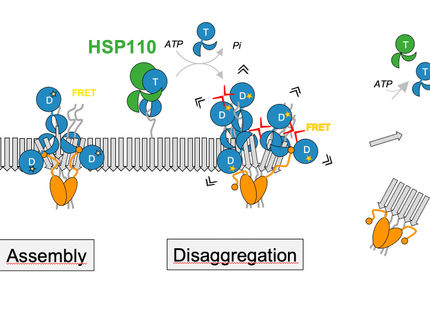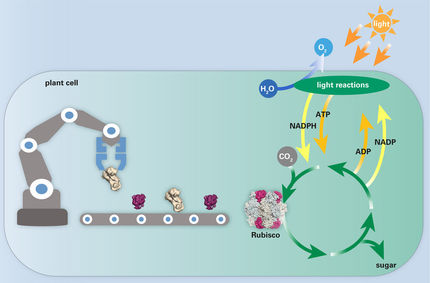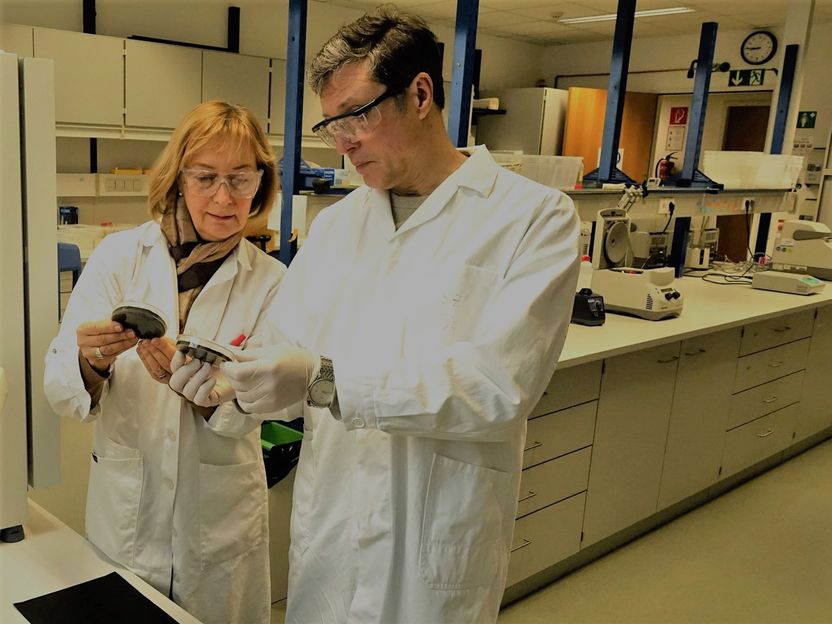Folded and misfolded protein levels in cells
The findings pave the way to discover new drugs for misfolding diseases
Scientists have long needed better tools for making such measurements in cells, because protein misfolding is a major cause of damage to tissues. Disorders that feature excessive protein misfolding afflict millions of people worldwide and include Alzheimer's and Parkinson's diseases, the systemic amyloidoses and prion ("mad cow-type") infections, as well as common enzyme deficiencies.
"This new probe technology should lead to a better understanding of how to fold misfolding-prone proteins in cells," said Jeffery W. Kelly, chair of TSRI's Department of Molecular and Experimental Medicine, Lita Annenberg Hazen Professor of Chemistry and member of the Skaggs Institute for Chemical Biology at TSRI.
"The ability to quantify protein folding in a cell using this simple fluorescence-based technology should speed the development of new therapies."
The study, led by Kelly and his laboratory, is reported in the online Early Edition of the Proceedings of the National Academy of Sciences.
Profound consequences
Misfolded proteins have never been easy to distinguish from their normally folded counterparts, especially within cells, because both have the same sequence of amino acids. Yet the loss of the normally folded shape can have profound consequences—a misfolded protein typically will lose its function within a cell. Worse, misfolding may expose "sticky," previously concealed parts of a protein that cause it to start aggregating with other copies of itself, leading to dysfunction of tissue that does not easily regenerate.
Both loss-of-function and gain-of-toxic function mutations can lead to disease, often shortening lifespan. Boosting the folding systems or the capacity of the protein homeostasis network in cells can prevent or eliminate protein misfolding. These new probes allow scientists to quantify how adapting the protein homeostasis network enhances the folding of a particular protein.
In the new study, Kelly's team aimed to selectively tag only the folded and functional conformations of a protein-of-interest. In one case, to demonstrate proof-of-principle, the scientists employed a model protein, retroaldolase, a designed enzyme created by collaborator David Baker's laboratory at the University of Washington, Seattle. The team also used transthyretin (TTR), a protein whose misfolding and aggregation is known to lead to several fatal disorders, including cardiomyopathies and polyneuropathies. (The Kelly laboratory recently helped develop the first specific drug therapy for the TTR polyneuropathies.)
The team—particularly the three lead authors, graduate students Yu Liu and Yun Lei Tan and Research Associate Xin Zhang—accomplished the tagging reaction by designing and making "folding probes" that covalently labeled the properly folded, functional forms of the proteins, but not the misfolded forms. When the scientists added a solution of probe molecules to the soluble contents of cells containing the target proteins, they were able to quantify the folded target proteins from the light emitted by the probes' fluorescent beacons.
Toward better screens for new drugs
Probes that covalently react with folded and functional protein families have been devised before by the Cravatt lab at TSRI. However, their usefulness as folding probes had been questioned by the scientific community, because the very act of reacting a folding probe with a target folded and functional protein-of-interest stabilizes that state and usually increases the population of the folded and functional fraction, overrepresenting it. In the new study, however, the researchers used folding probes in combination with cell lysis and ATP depletion, which causes the chaperones in the cell to hold onto the unfolded proteome—preventing its folding, providing a snapshot of the folded protein-of-interest population, while minimizing overrepresentation of that state by the tagging process.
One of the most important applications of new probes like these will be for the rapid, "high-throughput" screening of very large drug compound libraries to identify drug candidates that prevent protein misfolding by improving the quality of cellular folding. "Using these probes to quantify the concentration of a functional, folded protein-of-interest, we can screen for compounds that boost this concentration, for example," said Zhang, who along with Kelly conceived and designed the study.
In this study, the researchers cleared another hurdle for the use of probes in high-throughput screens with the design of a probe whose fluorescent beacon isn't lit all the time, but only turns on when it reacts with the folded protein-of-interest. "That fluorescent signal quickly shows you the concentration of the folded, functional protein that was in the cell at the time of lysis," Zhang said. "There is no need for the time-consuming removal of fluorescence probes that aren't bound to targets or separation of the probe–protein-of-interest conjugate."
Drugs that reduce the misfolding of specific proteins by altering cell biology of protein homeostasis might one day be used to prevent or delay age-related neurodegenerative diseases, such as Alzheimer's and Parkinson's, and to treat inherited enzyme-deficiency disorders. Zhang, Kelly and their colleagues suspect that anti-misfolding drugs could have even broader applications, given the surprisingly large populations of misfolded proteins in cells and all the ways in which those misfolded proteins could be causing harm.






















































